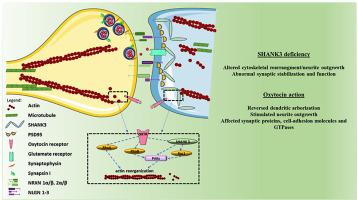Molecular and Cellular Endocrinology ( IF 3.8 ) Pub Date : 2020-06-30 , DOI: 10.1016/j.mce.2020.110924 Alexandra Reichova 1 , Zuzana Bacova 1 , Stanislava Bukatova 1 , Martina Kokavcova 1 , Veronika Meliskova 1 , Karel Frimmel 2 , Daniela Ostatnikova 3 , Jan Bakos 4

|
Oxytocin has been suggested as a potential therapeutic agent in autism and other neuropsychiatric conditions. Although, the link between the deficit in “SH3 domain and ankyrin repeat containing protein 3” (SHANK3) and autism spectrum disorders is highly studied topic, developmental mechanisms are still poorly understood. In this study, we clearly confirm that SHANK3 deficiency is accompanied with abnormalities in neurite number and length, which are reversed by oxytocin treatment (1 μM, 48h) in primary hippocampal neurons. Transient silencing for the SHANK3 gene (siSHANK3) in neuron-like cell line (SH-SY5Y) revealed a significant decrease in the expression levels of Neurexins 1α, 1β, 2α and 2β. Oxytocin treatment compensated reduced levels of Synapsin I, PSD95 and Neuroligin 3 in siSHANK3 cells suggesting a marked potential of oxytocin to ameliorate defects present in conditions of SHANK3 deficiency. Further analysis of hippocampal tissue revealed that oxytocin application (0.1 μg/μl, s.c. at P2 and P3 day) affects levels of synaptic proteins and GTPases in both WT and SHANK3 deficient mice on day P5. Oxytocin stimulated the mRNA expression of RhoB and Rac1 in both WT and SHANK3 deficient mice. Our data suggest that autism relevant synaptic pathologies could be reversed by oxytocin treatment.
中文翻译:

催产素可以在自闭症相关的SHANK3缺陷模型中恢复异常的神经元形态和突触蛋白。
催产素已被建议作为自闭症和其他神经精神疾病的潜在治疗剂。尽管“ SH3结构域和含锚蛋白重复序列蛋白3”(SHANK3)的缺陷与自闭症谱系障碍之间的联系已得到广泛研究,但对发展机制的了解仍很少。在这项研究中,我们清楚地确认,SHANK3缺陷伴有神经突数目和长度异常,这是通过原代海马神经元的催产素治疗(1μM,48h)逆转的。神经元样细胞系(SH-SY5Y)中SHANK3基因(siSHANK3)的瞬时沉默显示Neurexins1α,1β,2α和2β的表达水平显着降低。催产素治疗可补偿突触素I降低的水平,siSHANK3细胞中的PSD95和Neuroligin 3提示催产素具有明显的潜力,可改善SHANK3缺乏症中存在的缺陷。对海马组织的进一步分析表明,催产素的应用(P2和P3日为0.1μg/μl,皮下注射)会影响WT和SHANK3缺陷小鼠在P5天的突触蛋白和GTPases的水平。催产素刺激WT和SHANK3缺陷小鼠中RhoB和Rac1的mRNA表达。我们的数据表明,催产素治疗可以逆转自闭症相关的突触病理。催产素刺激WT和SHANK3缺陷小鼠中RhoB和Rac1的mRNA表达。我们的数据表明,催产素治疗可以逆转自闭症相关的突触病理。催产素刺激WT和SHANK3缺陷小鼠中RhoB和Rac1的mRNA表达。我们的数据表明,催产素治疗可以逆转自闭症相关的突触病理。










































 京公网安备 11010802027423号
京公网安备 11010802027423号